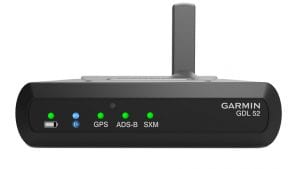ForeFlight and Garmin introduce new weather receivers
EAA Airventure Oshkosh is the aviation event of the summer, and it usually brings a number of product introductions. This year is proving to be no exception, with new airplanes, new engines, and new avionics all being announced over the last week. Two of the giants in the world of aviation apps and accessories, ForeFlight and Garmin, joined the fray this week. Here’s a look at what’s new and what it all means.
ForeFlight Scout
ForeFlight was first out of the gate, introducing Scout, a tiny ADS-B receiver that measures just 3.4″ x 0.8″. The device is made by uAvionix, a company known better in the world of drones than airplanes, which explains the compact size. Scout is a dual band ADS-B receiver (978 and 1090 MHz) that attaches to a window with a suction cup, and sends both weather and traffic information to ForeFlight via WiFi. At only $199, it’s the least expensive ADS-B receiver on the market, and seems targeted squarely at do-it-yourself ADS-B kits like Stratux.
That low price comes with some trade offs, though. Unlike most other ADS-B receivers, it does not include a GPS receiver or a built-in battery; you’ll need to plug it into a cigarette lighter or a backup battery pack for power, and you’ll need either a GPS in your iPad (included on LTE models) or a Bluetooth GPS receiver. There is also no AHRS for backup attitude or on-board memory for replaying weather, so you’ll need to keep your iPad screen on during the entire flight.
Scout is a bare-bones product, but we’ve flown with it and the performance wasn’t bad. We mounted the receiver to a side window, plugged it into the cigarette lighter, connected our iPad to the Scout WiFi network, and opened up ForeFlight. You can view subscription-free ADS-B weather and traffic on the moving map page, and there’s a status page that makes it easy to monitor performance and perform firmware upgrades. In our initial testing, Scout didn’t receive as many towers (2-3) as a Stratus 2S (4-5), but even at 1000 ft. AGL we were receiving weather so it should be a reliable option for most pilots. We had a couple of issues connecting to Scout’s WiFi network, but a quick iPad reboot solved it both times. Scout also allows multiple iPads to connect at the same time, which can be used for transferring flight plans between devices.
For pilots on a budget, or for someone considering building their own ADS-B receiver, Scout offers subscription-free weather and traffic at a great price. It fills out the range of products that work with ForeFlight as well: Scout, Stratus 1S, Stratus 2S and the SiriusXM SXAR1 offer different features at different prices for different missions. Learn more
Garmin GDL 51
Garmin also announced a new weather receiver, part of a slew of product introductions that included everything from autopilots to new pilot watches. The GDL 51 is a SiriusXM receiver that finally gives pilots flying with the Garmin Pilot app or Garmin portable GPSs a solid option for satellite weather. Up until now, the GDL 39 ADS-B receiver was the only option for weather.
The compact GDL 51 sits on the glareshield and sends weather, GPS position, attitude information and even SiriusXM Radio to portable devices via Bluetooth. Since the weather comes from satellites, it’s available at any altitude (even on the ground) and even in most of southern Canada. There are also more weather products available on SiriusXM than there are with ADS-B, although it does require a monthly subscription.
The GDL 51 has a 7-hour battery, so it’s completely wireless, and it can drive two devices at once. The WAAS GPS and AHRS power the moving map and synthetic vision displays, making this a single-box solution for most pilots. Audio can be sent to headsets wirelessly via Bluetooth, but there’s also an audio-out jack for connecting to headsets or audio panels. At $649 – only $449 after a $200 SiriusXM rebate – the price is right. This also includes three months of SiriusXM weather and radio. We expect aera 660 owners and Garmin Pilot fans will appreciate the new option, especially for those who fly turbine airplanes or in Canada. Learn more
Garmin also offers a remote-mount version, called the GDL 51R, which is an appealing option for homebuilders or aircraft owners who want to more permanently install the receiver.
Garmin GDL 52
For pilots who don’t want to choose between ADS-B and SiriusXM weather, Garmin offers the all-in-one GDL 52. This has pretty much all the features you could want: ADS-B weather, dual band ADS-B traffic, SiriusXM weather and radio, GPS, AHRS, and a built-in battery. A typical setup might be to use the SiriusXM for high resolution weather and the ADS-B for traffic. Alternately, pilots could use the free ADS-B weather in the US, then switch to SiriusXM in Canada. There’s a lot of flexibility.
Just like its sibling, the GDL 52 can connect to two devices wirelessly at the same time, and the battery lasts for 5 hours. Five indicator lights on the front of the device tell pilots the state of the battery, Bluetooth connection, GPS, ADS-B and SXM reception.
The GDL 52 isn’t shipping until late 2017, so pilots will have to wait to fly with it, but the feature list is impressive. It will retail for $1149, or $949 after the $200 SiriusXM rebate. That makes it one of the most expensive weather receivers for iPad, but then again, it has a mix of tools that no other product offers.
- Flying with the Garmin D2 Mach 2 and D2 Air X15 - October 28, 2025
- Weather planning with Garmin Pilot: widgets and flight profile - October 22, 2025
- Ready to start flying with Starlink internet? Listen to this podcast first - October 9, 2025






